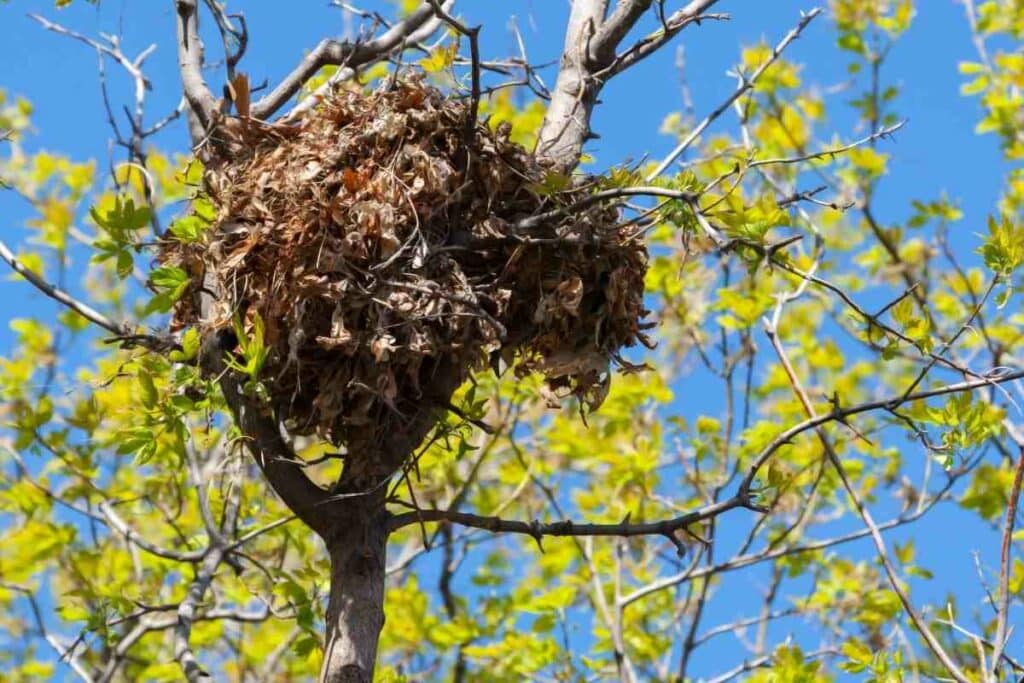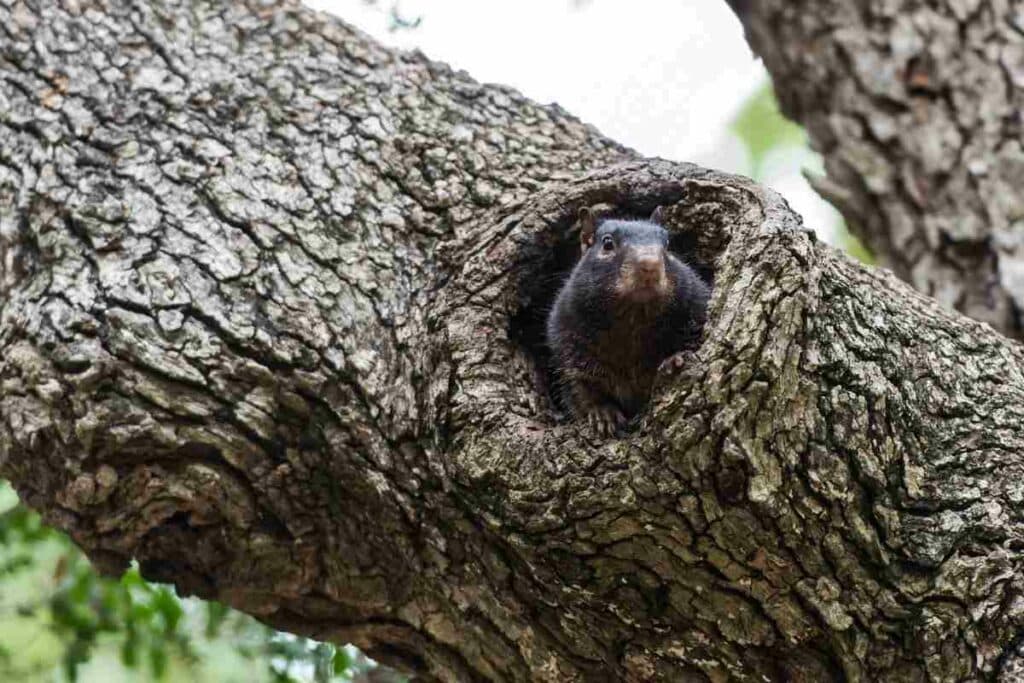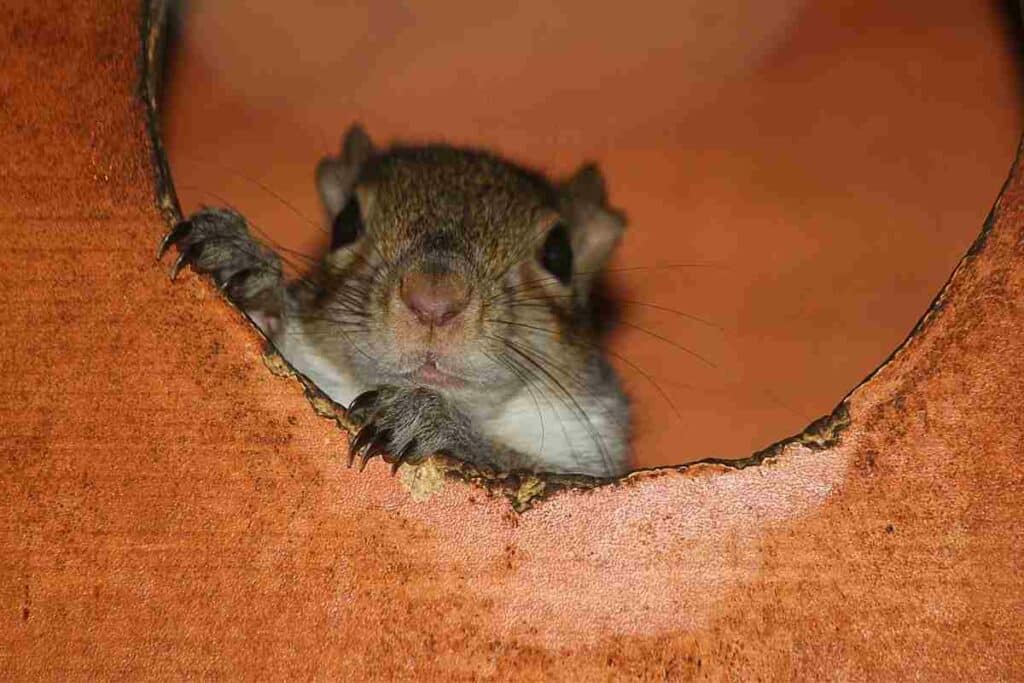Squirrels can build multiple nests every year, and it’s not unusual to see them return and reuse an old nesting area. If the old nest is still intact, they can reuse it multiple times.
Otherwise, they may build a new one in the same tree or area, or even use an abandoned nest that meets their needs.
Why Do Squirrels Come Back to the Same Place Annually?
Squirrels are creatures of habit. They tend to stay in one area, only moving more than a mile away if there is a shortage of food, water, or safety.
Squirrels’ activity range is less than 5 miles, meaning they stay in the same area their whole lives. If the squirrel’s nest is sturdy against wind, free of pests, and protective against predators, the squirrel is likely to reuse it annually. As the old saying goes, “If it ain’t broke, don’t fix it.”
Squirrels have babies twice per year, in mid-summer and early spring. These baby squirrels are raised in the nest and cannot survive independently until they are fully furred and capable of wandering. This means the mother squirrels must keep them protected in a squirrel nest, or drey.
As with most mammals, squirrels look for safety for themselves and their young. If they have found or created a good enough nest for this purpose, they will return to the same nesting area each year until something changes.
Dreys are usually built between June and July by both males and females. For those babies born in spring, this is a time to observe and learn from their mothers’ nest-building technique.
Many squirrels may utilize multiple nests at once, moving their offspring to a new nest after a few weeks for safety reasons.
Where Do Squirrels Nest?
Most dreys are found on tree branches that are 20 feet or higher. Squirrels can also make homes in tree hollows, which are preferable to dreys but harder to find.
Squirrels choose these heights to keep their offspring far from ground predators, such as weasels, badgers, coyotes, and foxes. They prefer to live in hardwood, nut trees, or oak-hickory forests, which provide study nesting trees and nuts for food.
Squirrels are very adaptable creatures, living in North and South America, Europe, Africa, and Asia.
Some squirrels live in burrows and a series of underground tunnels. These are called ground squirrels.
Tree squirrels usually live alone, and mothers live with their offspring. A female squirrel can have between 1-7 offspring per litter. If the winter months are especially cold, squirrels may congregate in groups, temporarily occupying one nest together to maximize body warmth.
Types of Squirrel Nests
Ground squirrels live in burrows, which means they don’t construct nests the way tree squirrels do. There are two types of tree squirrel nests: leaf nests and tree (cavity) dens.
Squirrel Leaf Nests
Leaf nests, or dreys, are the squirrel homes you’re most likely to see – especially in the fall when deciduous trees lose their leaves. These nests are hollow spheres that are about a foot or more in diameter.
While they look messy from afar, leaf nests are an elaborate construction of twigs, leaves, branches, moss, grass, shredded bark, and/or pine needles.

These nests have an entrance that usually faces opposite the wind and towards the trunk or branch. Some may even include a second exit as an emergency escape route.
Squirrel leaf nests have differences depending on the type of squirrel and the environment.
The average drey is used for a couple of years before being abandoned, although some have been observed in use for up to ten years.
Squirrels will abandon their dreys if predators find them or if they are overrun by lice or fleas. This is one reason that a squirrel may have and use multiple dreys in the same year.
Squirrel Tree Dens
The squirrels who find and inhabit a tree cavity are in luck. Their offspring are 40% more likely to survive than those offspring living in leaf nests.
Since tree dens usually have small entrances that block larger predators from entering, this provides the safest haven for squirrels throughout the world.

Squirrels may still create a small nest within the tree cavity using sticks and leaves, but it will likely be much smaller than the leaf nest counterpart.
Squirrel tree dens are rarely abandoned and, if they are, they will quickly be occupied again by another creature looking for solid shelter.
Other Nesting Areas
Squirrels are resourceful creatures, and sometimes they create nests in unnatural places, such as attics or sheds. Find out how to get rid of an unwanted squirrel’s nest below.

How Do I Get Rid of a Squirrel’s Nest?
If you have a squirrel’s nest that is intruding on your property, you can remove it yourself or through a tree or pest control service.
If the squirrels are not bothering you or your garden, consider keeping the nests intact. Most squirrels are harmless and an important part of the natural ecosystem.
If you must get rid of a nest, do so only once it’s been abandoned and there are no live young within the nest. Most young leave the nest by 10 weeks old.
Sometimes, after the offspring leave the mother remains in the nest. In this case, start removing the nest mid-morning on a sunny day. That is when the mother will be out feeding.
Removing a Squirrel’s Nest on Your Own
Since squirrels tend to return to the same area to renest, you may want to trap the squirrel and release it more than 5 miles from your home. This is the closest thing to assuring that the squirrel won’t come back to rebuild on your property.
If the squirrel has nested in your attic, you can wait until mid-summer to remove the nest and block any small holes for entry, as the summer heat often drives the squirrels out of attics until fall.
Removing a nest from a high position in a tree is very dangerous and is not recommended to do without professional assistance.
Removing a Squirrel’s Nest Professionally
Most pest control services offer a humane removal of squirrels and their nests. These professional companies are optimal for sealing small spaces in your attic or shed where squirrels may return to create a new nest.
To remove nests high up in your trees, contact your nearest tree service company.
Squirrel Facts
Here are some interesting facts about squirrels.
- Most squirrels live between 3-4 years.
- A squirrel’s front teeth grow throughout its life; it gnaws on things to wear them down.
- Squirrels are born blind and deaf.
- Squirrels bury food to save it for winter.
- Squirrels can find food they buried under up to a foot of snow.
- Squirrels can survive jumps from up to 20 feet.
- Squirrels are omnivores.
Final Thoughts on Squirrels Coming Back to the Same Place Annually
Much like humans, squirrels are predictable creatures. They remain in the same geographical area for their entire lives and tend to reuse their old nests.
A squirrel’s nest is its source of protection against the weather and predators. Without it, blind and deaf baby squirrels would never be able to reach adulthood.
Squirrels can nest in tree nests, tree dens, or burrows. Sometimes they find their way into our attics or sheds too. You can remove a squirrel nest when it does not contain offspring on your own or through a professional company.
